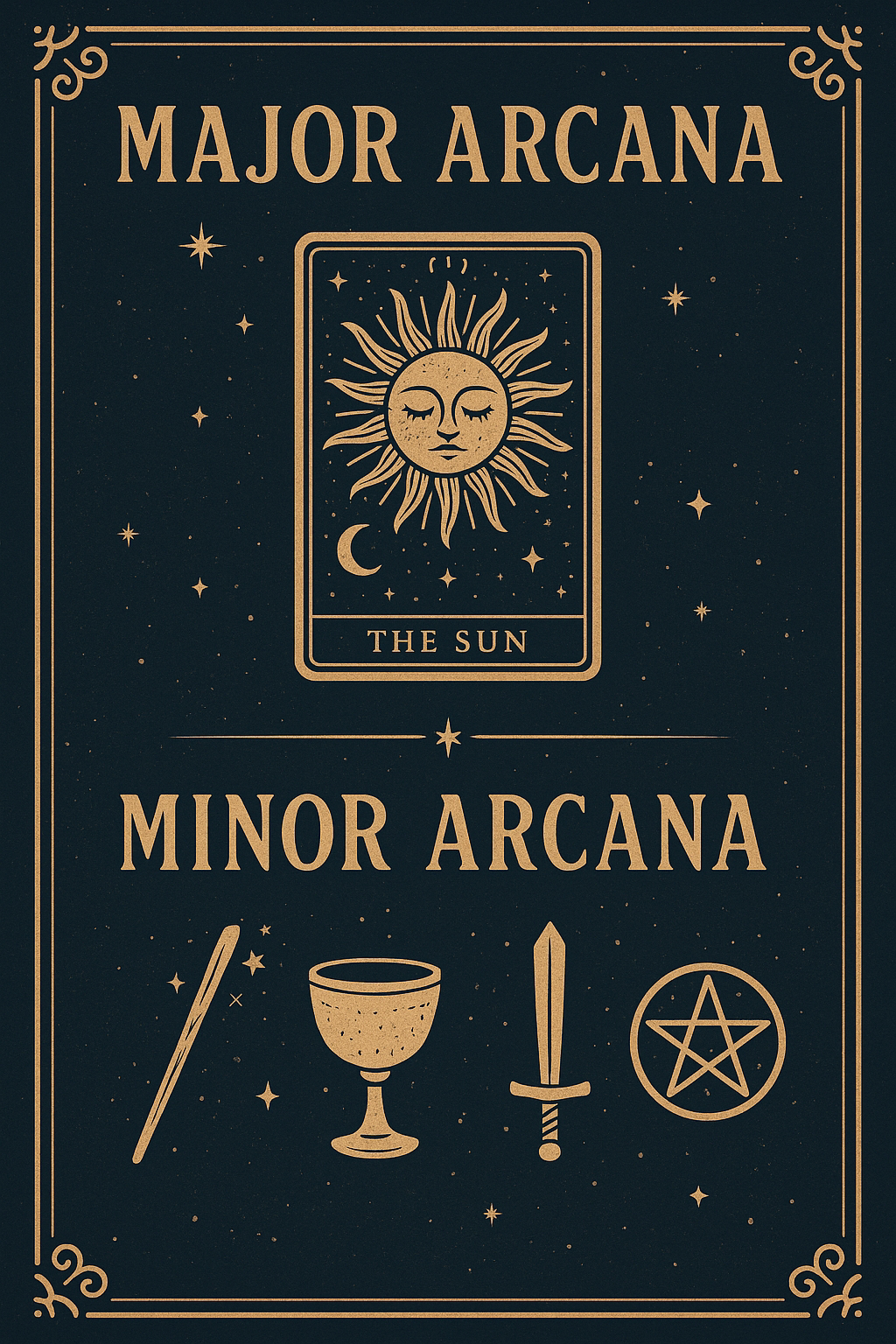Whether you’re a beginner holding your first deck or a seasoned reader looking to deepen your practice, let’s explore what sets tarot and oracle apart — and why you might want to use one, the other, or both.
Structure: The Blueprint of the Deck
One of the most obvious differences between tarot and oracle decks lies in their structure.
Tarot decks follow a traditional framework that has been in place for hundreds of years. Most tarot decks contain 78 cards:
- 22 Major Arcana cards, representing big life themes and spiritual lessons (think The Fool, The Lovers, Death, The World).
- 56 Minor Arcana cards, divided into four suits (often Wands, Cups, Swords, and Pentacles), each containing numbered cards (Ace through Ten) and court cards (Page, Knight, Queen, King).
This structure gives tarot a sense of consistency. Once you learn the core meanings and the layout, you can apply that knowledge to nearly any tarot deck you pick up.
Oracle decks, on the other hand, are like the free-spirited cousins of tarot. They have no set number of cards and no strict suits or arcana. One deck might have 44 cards focused entirely on angelic messages; another could have 60 cards themed around animal spirit guides. The structure (or lack thereof) is entirely up to the creator, which means every oracle deck is unique.
Reading Style: How They Speak
Because of its set framework, tarot is often considered a more detailed, structured tool for divination. The combination of Major and Minor Arcana cards can pinpoint specific influences in your life — both major turning points and everyday circumstances. Tarot spreads (layouts) tend to be more formulaic, allowing for in-depth storytelling within a reading.
Oracle cards are generally more fluid in their messaging. They often carry a broader, more thematic approach, giving you big-picture insight or emotional guidance. Many oracle decks come with keywords or full sentences on the cards, making them easier for beginners to read intuitively without memorizing meanings.
Think of tarot as a conversation with a detail-oriented friend who lays out all the pros and cons. Oracle is more like talking to a wise mentor who offers you the overarching lesson and encouragement you need.
Imagery and Symbolism
Tarot imagery often follows symbolic traditions, especially in decks inspired by the Rider–Waite–Smith or Thoth systems. These symbols — from astrological signs to numerology — carry layers of meaning that deepen readings over time. Learning tarot symbolism is like learning a new language: the more fluent you become, the richer your readings.
Oracle imagery is entirely dependent on the deck’s creator. It might focus on flowers, animals, chakras, affirmations, or mystical beings. The symbolism is usually more straightforward and tailored to the deck’s theme, making it accessible for quick readings without extensive study.
Learning Curve
For beginners, tarot can feel a bit intimidating. Memorizing 78 card meanings, plus reversed interpretations if you choose to use them, takes time and practice. However, this effort pays off with the ability to perform highly detailed, nuanced readings.
Oracle cards are generally easier to pick up and use right away. Because many have guidebooks with direct messages or even the meaning printed on the card, you can start reading immediately without years of study. That said, mastering oracle reading still takes intuition and connection with the cards — it’s just less about memorization and more about tuning into the message.
When to Use Tarot vs. Oracle
Many readers use tarot when they want detail, specifics, or to explore the “why” behind a situation. It’s great for mapping out timelines, identifying obstacles, and uncovering hidden influences.
Oracle decks shine when you need encouragement, spiritual guidance, or an overview. They’re perfect for daily pulls, affirmations, or when you want to tap into a particular energy — such as creativity, self-love, or courage.
Some readers blend the two: they’ll do a full tarot spread and then pull an oracle card at the end to give the reading an overarching message or “final word.”
Choosing the Right Deck for You
When deciding between tarot and oracle, ask yourself:
- Do I want structure or freedom? Tarot offers a universal structure; oracle lets you create your own rules.
- Am I willing to commit to learning a system? Tarot requires more study; oracle can be read right out of the box.
- What type of readings do I want to do? Tarot excels in detailed analysis; oracle focuses on themes and emotions.
If you’re unsure, you don’t have to choose just one. Many readers own both and use them interchangeably depending on the question and the energy of the day.
Building a Relationship With Your Deck
No matter which you choose, the most important factor in reading cards — tarot or oracle — is the relationship you build with your deck. Spend time with it. Shuffle daily, pull cards, write down your impressions, and note how the cards’ messages show up in your life.
Cleansing your deck (with smoke, moonlight, crystals, or simply intention) helps keep the energy fresh. Storing it in a cloth bag, box, or special space can make it feel more personal and connected to your practice.
The Bottom Line
Tarot and oracle are both powerful tools, but they shine in different ways. Tarot offers structure, depth, and a language that can be learned and shared across decks. Oracle gives you flexibility, ease of use, and thematic focus. Neither is “better” — it’s all about which tool resonates with your style, your intuition, and your goals.
If possible, try both. Let tarot challenge your analytical side while oracle nurtures your intuitive spirit. You may find they complement each other beautifully, creating a richer and more layered practice than either could provide alone.



